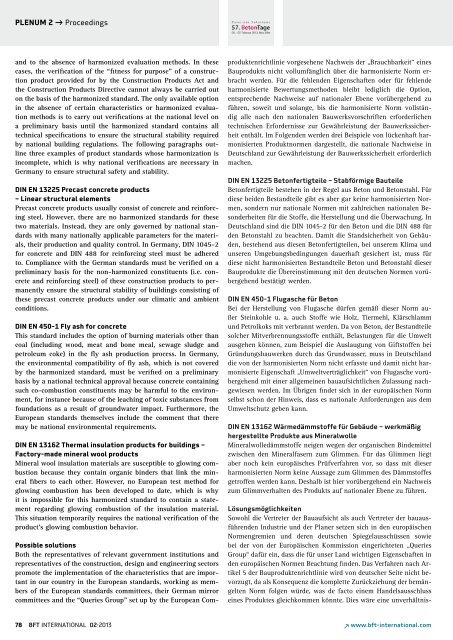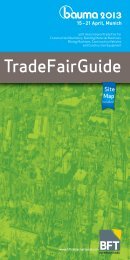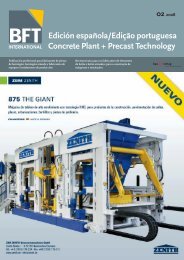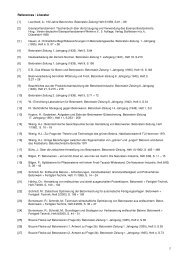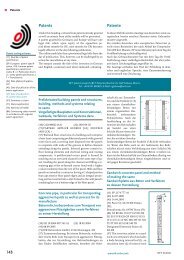KONGRESSUNTERLAGEN | PROCEEDINGS - Bft-international.com
KONGRESSUNTERLAGEN | PROCEEDINGS - Bft-international.com
KONGRESSUNTERLAGEN | PROCEEDINGS - Bft-international.com
Sie wollen auch ein ePaper? Erhöhen Sie die Reichweite Ihrer Titel.
YUMPU macht aus Druck-PDFs automatisch weboptimierte ePaper, die Google liebt.
PLENUM 2 → Proceedings<br />
and to the absence of harmonized evaluation methods. In these<br />
cases, the verification of the “fitness for purpose” of a construction<br />
product provided for by the Construction Products Act and<br />
the Construction Products Directive cannot always be carried out<br />
on the basis of the harmonized standard. The only available option<br />
in the absence of certain characteristics or harmonized evaluation<br />
methods is to carry out verifications at the national level on<br />
a preliminary basis until the harmonized standard contains all<br />
technical specifications to ensure the structural stability required<br />
by national building regulations. The following paragraphs outline<br />
three examples of product standards whose harmonization is<br />
in<strong>com</strong>plete, which is why national verifications are necessary in<br />
Germany to ensure structural safety and stability.<br />
DIN EN 13225 Precast concrete products<br />
– Linear structural elements<br />
Precast concrete products usually consist of concrete and reinforcing<br />
steel. However, there are no harmonized standards for these<br />
two materials. Instead, they are only governed by national standards<br />
with many nationally applicable parameters for the materials,<br />
their production and quality control. In Germany, DIN 1045-2<br />
for concrete and DIN 488 for reinforcing steel must be adhered<br />
to. Compliance with the German standards must be verified on a<br />
preliminary basis for the non-harmonized constituents (i.e. concrete<br />
and reinforcing steel) of these construction products to permanently<br />
ensure the structural stability of buildings consisting of<br />
these precast concrete products under our climatic and ambient<br />
conditions.<br />
DIN EN 450-1 Fly ash for concrete<br />
This standard includes the option of burning materials other than<br />
coal (including wood, meat and bone meal, sewage sludge and<br />
petroleum coke) in the fly ash production process. In Germany,<br />
the environmental <strong>com</strong>patibility of fly ash, which is not covered<br />
by the harmonized standard, must be verified on a preliminary<br />
basis by a national technical approval because concrete containing<br />
such co-<strong>com</strong>bustion constituents may be harmful to the environment,<br />
for instance because of the leaching of toxic substances from<br />
foundations as a result of groundwater impact. Furthermore, the<br />
European standards themselves include the <strong>com</strong>ment that there<br />
may be national environmental requirements.<br />
DIN EN 13162 Thermal insulation products for buildings –<br />
Factory-made mineral wool products<br />
Mineral wool insulation materials are susceptible to glowing <strong>com</strong>bustion<br />
because they contain organic binders that link the mineral<br />
fibers to each other. However, no European test method for<br />
glowing <strong>com</strong>bustion has been developed to date, which is why<br />
it is impossible for this harmonized standard to contain a statement<br />
regarding glowing <strong>com</strong>bustion of the insulation material.<br />
This situation temporarily requires the national verification of the<br />
product’s glowing <strong>com</strong>bustion behavior.<br />
Possible solutions<br />
Both the representatives of relevant government institutions and<br />
representatives of the construction, design and engineering sectors<br />
promote the implementation of the characteristics that are important<br />
in our country in the European standards, working as members<br />
of the European standards <strong>com</strong>mittees, their German mirror<br />
<strong>com</strong>mittees and the “Queries Group” set up by the European Comproduktenrichtlinie<br />
vorgesehene Nachweis der „Brauchbarkeit“ eines<br />
Bauprodukts nicht vollumfänglich über die harmonisierte Norm erbracht<br />
werden. Für die fehlenden Eigenschaften oder für fehlende<br />
harmonisierte Bewertungsmethoden bleibt lediglich die Option,<br />
entsprechende Nachweise auf nationaler Ebene vorübergehend zu<br />
führen, soweit und solange, bis die harmonisierte Norm vollständig<br />
alle nach den nationalen Bauwerksvorschriften erforderlichen<br />
technischen Erfordernisse zur Gewährleistung der Bauwerkssicherheit<br />
enthält. Im Folgenden werden drei Beispiele von lückenhaft harmonisierten<br />
Produktnormen dargestellt, die nationale Nachweise in<br />
Deutschland zur Gewährleistung der Bauwerkssicherheit erforderlich<br />
machen.<br />
DIN EN 13225 Betonfertigteile – Stabförmige Bauteile<br />
Betonfertigteile bestehen in der Regel aus Beton und Betonstahl. Für<br />
diese beiden Bestandteile gibt es aber gar keine harmonisierten Normen,<br />
sondern nur nationale Normen mit zahlreichen nationalen Besonderheiten<br />
für die Stoffe, die Herstellung und die Überwachung. In<br />
Deutschland sind die DIN 1045-2 für den Beton und die DIN 488 für<br />
den Betonstahl zu beachten. Damit die Standsicherheit von Gebäuden,<br />
bestehend aus diesen Betonfertigteilen, bei unserem Klima und<br />
unseren Umgebungsbedingungen dauerhaft gesichert ist, muss für<br />
diese nicht harmonisierten Bestandteile Beton und Betonstahl dieser<br />
Bauprodukte die Übereinstimmung mit den deutschen Normen vorübergehend<br />
bestätigt werden.<br />
DIN EN 450-1 Flugasche für Beton<br />
Bei der Herstellung von Flugasche dürfen gemäß dieser Norm außer<br />
Steinkohle u. a. auch Stoffe wie Holz, Tiermehl, Klärschlamm<br />
und Petrolkoks mit verbrannt werden. Da von Beton, der Bestandteile<br />
solcher Mitverbrennungsstoffe enthält, Belastungen für die Umwelt<br />
ausgehen können, zum Beispiel die Auslaugung von Giftstoffen bei<br />
Gründungsbauwerken durch das Grundwasser, muss in Deutschland<br />
die von der harmonisierten Norm nicht erfasste und damit nicht harmonisierte<br />
Eigenschaft „Umweltverträglichkeit“ von Flugasche vorübergehend<br />
mit einer allgemeinen bauaufsichtlichen Zulassung nachgewiesen<br />
werden. Im Übrigen findet sich in der europäischen Norm<br />
selbst schon der Hinweis, dass es nationale Anforderungen aus dem<br />
Umweltschutz geben kann.<br />
DIN EN 13162 Wärmedämmstoffe für Gebäude – werkmäßig<br />
hergestellte Produkte aus Mineralwolle<br />
Mineralwolledämmstoffe neigen wegen der organischen Bindemittel<br />
zwischen den Mineralfasern zum Glimmen. Für das Glimmen liegt<br />
aber noch kein europäisches Prüfverfahren vor, so dass mit dieser<br />
harmonisierten Norm keine Aussage zum Glimmen des Dämmstoffes<br />
getroffen werden kann. Deshalb ist hier vorübergehend ein Nachweis<br />
zum Glimmverhalten des Produkts auf nationaler Ebene zu führen.<br />
Lösungsmöglichkeiten<br />
Sowohl die Vertreter der Bauaufsicht als auch Vertreter der bauausführenden<br />
Industrie und der Planer setzen sich in den europäischen<br />
Normengremien und deren deutschen Spiegelausschüssen sowie<br />
bei der von der Europäischen Kommission eingerichteten „Queries<br />
Group“ dafür ein, dass die für unser Land wichtigen Eigenschaften in<br />
den europäischen Normen Beachtung finden. Das Verfahren nach Artikel<br />
5 der Bauproduktenrichtlinie wird von deutscher Seite nicht bevorzugt,<br />
da als Konsequenz die komplette Zurückziehung der bemängelten<br />
Norm folgen würde, was de facto einem Handelsausschluss<br />
eines Produktes gleichkommen könnte. Dies wäre eine unverhältnis-<br />
78 BFT INTERNATIONAL 02·2013 ↗ www.bft-<strong>international</strong>.<strong>com</strong>


